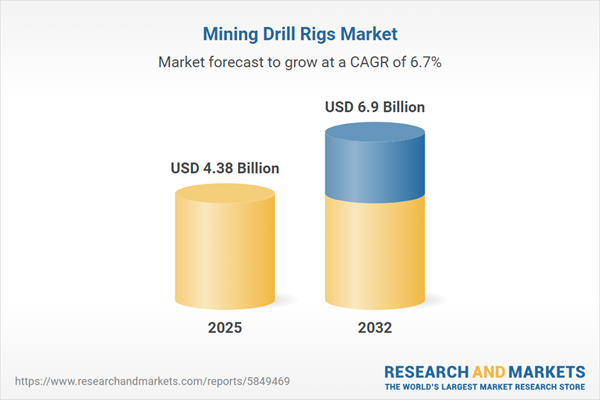Speak directly to the analyst to clarify any post sales queries you may have.
Senior decision-makers in the mining drill rigs market are navigating rapid industry shifts by embracing digital innovation, operational agility, and evolving regulations. Strategic alignment with advanced technologies and sustainability goals is vital for organizations seeking consistent performance and long-term growth.
Market Snapshot: Mining Drill Rigs Market
The Mining Drill Rigs Market is advancing as automation and smart control systems reshape operational standards. In 2024, the market reached USD 4.10 billion, with forecasts estimating USD 4.38 billion in 2025 and USD 6.90 billion by 2032, indicating a compound annual growth rate (CAGR) of 6.72%.
Investments continue to flow into adaptive drilling technologies, enabling greater equipment customization and expanded reach. Industry leaders are prioritizing modernization, expanding their regional presence, and maintaining a strong focus on productivity, sustainability, and compliance to meet updated benchmarks.Scope & Segmentation
- Rig Types: Crawler-mounted, track-mounted, and wheeled rigs are selected to deliver reliability across remote, urban, and mixed-terrain environments, supporting tailored project requirements.
- Applications: Horizontal drilling, vertical drilling, geotechnical exploration, blast hole drilling, and core drilling enable comprehensive resource extraction for mining, energy, and civil infrastructure initiatives.
- End Users: Mining, construction, infrastructure, and oil and gas sectors shape technical specifications to achieve operational efficiency and meet project objectives.
- Operating Mechanisms: Electric, hydraulic, manual, and pneumatic systems offer flexibility and enhance safety, supporting automation priorities in challenging settings.
- Power Output: Equipment ranges from entry-level models for site surveys to high-capacity solutions for demanding drilling applications, matching diverse geological demands.
- Depth Capacity: Solutions address shallow and ultra-deep drilling, equipping organizations to advance from surface-level extraction to complex subsurface projects.
- Geographic Regions: The Americas, Europe, Middle East, Africa, and Asia-Pacific each present unique regulatory and investment environments. Growth opportunities vary by adoption pace and evolving user needs in each region.
- Leading Companies: Key players such as Atlas Copco AB, Sandvik AB, Epiroc AB, Caterpillar Inc., Boart Longyear Ltd., Furukawa Co., Ltd., Soilmec S.p.A., Liebherr-International Deutschland GmbH, Bauer Maschinen GmbH, and Komatsu Ltd. are expanding technical capacity and regional reach to address rising demands.
Key Takeaways for Senior Decision-Makers
- Integrated automation and smart controls provide enhanced visibility and cohesive management across operations, enabling efficient oversight of dispersed locations.
- Predictive maintenance, powered by real-time analytics, helps to reduce unplanned outages and sustains asset value over the equipment lifecycle.
- Heightened sustainability and regulatory expectations are driving investment in digital monitoring and environmentally responsible processes, making compliance a catalyst for competitive advantage.
- Advanced project management platforms empower leaders to allocate resources efficiently, ensuring consistent delivery for projects of various sizes.
- Modular and multi-purpose rig adoption allows quick adaptation to changing field requirements, optimizing capital use and supporting agility onsite.
- Access to comprehensive aftermarket digital solutions and integrated support services enhances equipment performance and nurtures stronger supplier relationships.
Tariff Impact on Mining Drill Rigs Market
US tariffs on imported mining drill rigs and their components are reshaping cost structures throughout the supply chain. Organizations are responding by expanding domestic production and deepening relationships with local suppliers, which bolsters regulatory compliance and operational resilience. Procurement teams are reconfiguring supply strategies to safeguard against further regulatory fluctuations and maintain continuity.
Methodology & Data Sources
This report combines firsthand insights from industry executives, analysis of mining sites, and thorough reviews of technical and regulatory material. A robust triangulation method ensures that findings are reliable and actionable for senior leaders.
Why This Report Matters
- Facilitates targeted strategic planning, helping organizations recognize and leverage core advantages as the landscape evolves.
- Provides data-centric insights to guide navigation through complex compliance and supply logistics in global markets.
- Enables informed technology investments and directs resource allocation based on sector-specific intelligence and regional requirements.
Conclusion
Organizations prioritizing digital integration and resilient supply strategies are well-positioned to enhance efficiency and meet current and emerging challenges in the mining drill rigs market.
Additional Product Information:
- Purchase of this report includes 1 year online access with quarterly updates.
- This report can be updated on request. Please contact our Customer Experience team using the Ask a Question widget on our website.
Table of Contents
3. Executive Summary
4. Market Overview
7. Cumulative Impact of Artificial Intelligence 2025
Companies Mentioned
The companies profiled in this Mining Drill Rigs market report include:- Atlas Copco AB
- Sandvik AB
- Epiroc AB
- Caterpillar Inc.
- Boart Longyear Ltd.
- Furukawa Co., Ltd.
- Soilmec S.p.A.
- Liebherr-International Deutschland GmbH
- Bauer Maschinen GmbH
- Komatsu Ltd.
Table Information
| Report Attribute | Details |
|---|---|
| No. of Pages | 193 |
| Published | November 2025 |
| Forecast Period | 2025 - 2032 |
| Estimated Market Value ( USD | $ 4.38 Billion |
| Forecasted Market Value ( USD | $ 6.9 Billion |
| Compound Annual Growth Rate | 6.7% |
| Regions Covered | Global |
| No. of Companies Mentioned | 11 |









